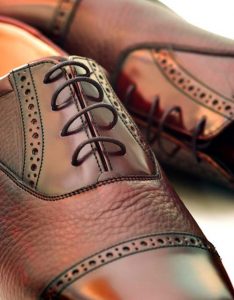The History of Shoemaking and Footwear
Shoes are as old as history itself. From the earliest records of man, we find mentions of shoes. There’s little wonder as are shoes vital for protection, function and – most importantly to some – fashion. As early as 1,000 – 700 B.C., shoes, in the form of sandals, were created to allow early man to walk through dense jungle, jagged rock, burning sands and other hazards without injury. 
How early shoes were made and worn
Made primarily of various types of bark, leaves and rawhide, the first shoes fell into two categories: sandals and moccasins. Both began with some sort of simple sole that was strapped to the foot. While sandals were found mainly in warmer regions and shielded the sole of the foot, moccasins offered greater protection to those living in colder areas of the world. With tanned animal hides, primitive shoemakers would punch holes around the circumference then weave vines through the holes and enclose the foot in the hide added warmth.
A progression through the centuries shows distinct trends in three areas: function, protection and fashion. For example, in Medieval times, the toes on men’s shoes grew longer and more pointed. A sign of status, the longer the toe, the better. Women, however, wore ankle shoes with side laces. As we reached the middle ages, men’s and women’s shoes morphed into round and squares toe shapes with the soles becoming wider.
By the late 1500s, shoemakers began to incorporate higher heels on women’s shoes and more functional heels on men’s shoes. From dainty lady’s styles to “Oxford” boots first worn by students at Oxford University in the 17th century, heels began to draw as much attention as toes.
Automation Changes Shoemaking Forever
Modern technology allowed for new innovations in footwear including a move from ribbon-tied shoes to buckles. It also brought forth automated shoemaking machinery, something that cobblers had struggled to develop for years. With the use of a rolling machine, what was once a lengthy process that cobblers would perform manually could be done more quickly. The machine could compound leather in order to make longer-lasting soles.
The invention of the sewing machine in 1846 open more doors to shoemakers. Hand stitching was eventually replaced with automated sewing via machine for virtually all cobblers. However, the age of automation has also marked the decline of the cobbler, turning shoemakers into industrialised shoe manufacturers.
The Global Influences of Shoes
Shoes have had a universal influence for centuries. The Dutch contributed bulky, leg boots reaching to the knee that provided protection as well as style. The English created “gored” shoes made using elastic panels to make putting on and removing shoes less time-consuming. Russia contributed the women’s walking boot, which laced from mid-foot to shin and also the first man’s hiking boot. Named the Alpine boot, these shoes were designed with bent nails on the underside of the sole for added traction for Alpine climbers.
From sophisticated, high heel ladies pumps to the steel-toe boots of a construction worker, shoes have evolved to serve virtually every purpose. There are athletic shoes engineered with technology that has been proven to make basketball icon Michael Jordan run faster. We have diamond-embellished formal shoes, eel-skin men’s shoes and even children’s shoes that light up and make noise. One might think we’ve gone as far as possible moving from basic necessity to status symbol and fashion plate. What does the future of shoes hold? Only innovation and imagination can tell!
